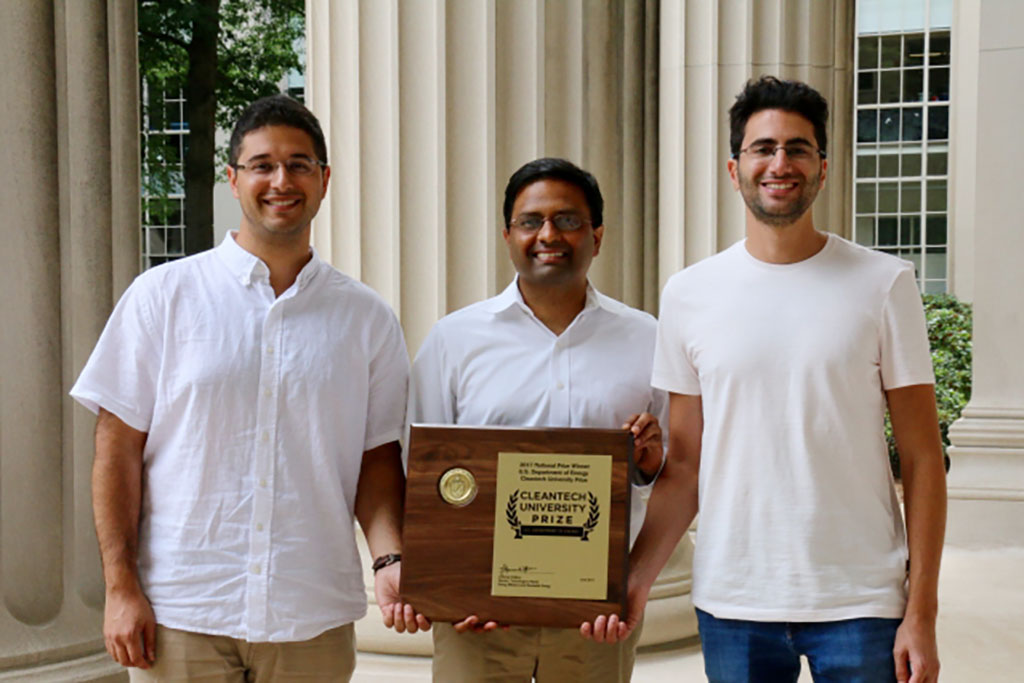Infinite Cooling wins Cleantech University Prize competition
Infinite Cooling, an energy startup founded at MIT, pitched its business plan to a panel of energy experts and won first place at the second annual Cleantech University Prize (UP) national competition in Austin, Texas, hosted by the U.S. Department of Energy (DOE).
Infinite Cooling researchers, including MIT Associate Professor Kripa Varanasi and graduate students Maher Damak and Karim Khalil, all from the Department of Mechanical Engineering, have been fine-tuning their business pitch through several rounds of rigorous competition. After receiving the audience choice award at the 2017 MIT $100K Accelerate earlier this year, the team continued on to pitch at the MIT Clean Energy Prize competition, where they qualified for the national DOE Cleantech UP competition.
The Cleantech UP competition launched in 2015 with the goal of engaging and empowering the next generation of clean energy entrepreneurs and innovators to effectively translate their ambitious energy ideas into a reality. Collectively, participants from the annual Cleantech competitions have already formed over 200 ventures and raised over $120 million in follow-on funding.
In addition to receiving training, investor feedback, and personalized coaching, the Infinite Cooling team had the opportunity to form valuable connections in the power industry and startup sector.
“The mentoring has been great, whether it be the business side, the legal side, or the technical side. Quantifying our value proposition and thinking about new aspects of our business has been very useful,” says Khalil.
Reducing power plant water usage and costs
Infinite Cooling’s patent-pending technology uses electrical fields to recapture up to 80 percent of the water vapor plumes that would normally escape from cooling towers of power plants through evaporation. The resulting water from the collected steam is then recycled back into the cooling system.
“The power industry is a particularly interesting application for our technology because it has the biggest water needs. Power plants consume more than half of the country’s water and that inspired us to create a solution,” Khalil explains.
Damak adds, “A 250-megawatt power plant uses approximately 3,000 gallons of water every minute.” With over 7,000 power plants just in the United States, Infinite Cooling technology could have a significant environmental and economic impact worldwide, particularly in the U.S., China, India, and Europe.
By recapturing water vapor plumes and making cooling towers more of a closed system, Infinite Cooling’s technology could decrease power plant water consumption by as much as 30 percent. This translates into savings of millions of gallons of water, and millions of dollars, each year.
The technology could also be a solution for power plant regulatory issues in areas where plume generation curtailment is enforced or costly.
Balanced needs
Infinite Cooling technology highlights a balanced understanding of water and energy needs. If cooling technology is too energy-intensive and costs overshadow potential water savings, power plants may not be willing to adopt such a solution.
“We are really solving the problem at the water and energy nexus,” says Varanasi. Population considerations, he adds, are key: “Energy needs will double and there will be lots of water that is needed for these power plants. So much of that water is lost from the cooling towers, so if our technology can help recapture and reuse that water we could dramatically meet important environmental needs while saving power plants’ enormous water costs.”
“We are grateful for the Tata Center for Technology and Design’s early seed funding that helped us take it from an idea to a proof-of-product stage,” Varanasi says.
Future plans
Infinite Cooling is currently participating in the educational accelerator Delta V at MIT, which will help guide them in building a sustainable business. And with generous support from the MIT Office of Sustainability, Varanasi, Damak, and Khalil have begun an industrial pilot test at the local MIT Central Utilities Plant, where they are monitoring and gathering data on how water consumption changes with the use of their technology.
The next step, Varanasi says, is to spinoff and start a company so that the technology can be brought to not only the power industry, but also other industries such as commercial HVAC, large data centers, hospitals, and even resorts.
This research was supported by the MIT Tata Center for Technology and Design.


